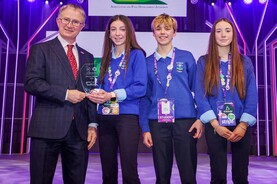To assist nature, 30 bat, bird, and bee boxes are being built on the Shannon Airport campus' neighbouring areas. The nest boxes are a component of the new Biodiversity Action Plan (BAP) for Shannon Airport Group, which was unveiled by broadcaster and environmentalist Éanna Ní Lamhna. They will be situated in the community biodiversity garden owned by the group, as well as in woodlands and other suitable habitat places spread out around the campus.
Students from St John’s National School Shannon received an educational workshop on flora and fauna by Ní Lamhna and guest speaker Philip Brennan, the Shannon Airport ornithologist. Local community groups, including Shannon Tidy Towns, Shannon Wetlands Community Group and the Men's Shed also attended the launch on Tuesday 27 June.
The plan, a project of the group's sustainability plan, seeks to collect information about the biodiversity existing on the group's lands and to maintain and conserve it using the best and most environmentally friendly practices. A "low mow" regime, pollinator-friendly planting, woodland enhancement, monitoring habitat change, and education, outreach and engagement are just a few of the measures it highlights.

Pictured are Philip Brennan, the Shannon Airport Ornithologist, Environmentalist and Broadcaster, Éanna Ní Lámhna, Arek Gdulinski, Sustainability Specialist, The Shannon Airport Group and Sinead Murphy, Head of Sustainability at The Shannon Airport Group .Pic Arthur Ellis.
Sinead Murphy, head of sustainability at the Shannon Airport Group said, that they plan to “take those necessary steps in the conservation and protection of our environment”, as its “mission is to become a biodiversity-friendly airport and business campus.”
Murphy said that their plans are to cover “not only the EU Natura 2000 sites designated as a Special Area of Conservation (SAC) and Special Protection Area (SPA), and the nationally important proposed Natural Heritage Area (NHA), but also the undesignated sites which exist within the airport lands and commercial properties”.
Ní Lamhna said: “We all have a part to play. The simplest of environmental management changes can bring huge improvement in biodiversity. Here on the Shannon campus, there is already the return of marsh orchids and bee orchids thanks to a low mow regime. It will get better and better as the action plan is further rolled out.”
To assist nature, 30 bat, bird, and bee boxes are being built on the Shannon Airport campus' neighbouring areas. The nest boxes are a component of the new Biodiversity Action Plan (BAP) for Shannon Airport Group, which was unveiled by broadcaster and environmentalist Éanna Ní Lamhna. They will be situated in the community biodiversity garden owned by the group, as well as in woodlands and other suitable habitat places spread out around the campus.
Students from St John’s National School Shannon received an educational workshop on flora and fauna by Ní Lamhna and guest speaker Philip Brennan, the Shannon Airport ornithologist. Local community groups, including Shannon Tidy Towns, Shannon Wetlands Community Group and the Men's Shed also attended the launch on Tuesday 27 June.
The plan, a project of the group's sustainability plan, seeks to collect information about the biodiversity existing on the group's lands and to maintain and conserve it using the best and most environmentally friendly practices. A "low mow" regime, pollinator-friendly planting, woodland enhancement, monitoring habitat change, and education, outreach and engagement are just a few of the measures it highlights.

Pictured are Philip Brennan, the Shannon Airport Ornithologist, Environmentalist and Broadcaster, Éanna Ní Lámhna, Arek Gdulinski, Sustainability Specialist, The Shannon Airport Group and Sinead Murphy, Head of Sustainability at The Shannon Airport Group .Pic Arthur Ellis.
Sinead Murphy, head of sustainability at the Shannon Airport Group said, that they plan to “take those necessary steps in the conservation and protection of our environment”, as its “mission is to become a biodiversity-friendly airport and business campus.”
Murphy said that their plans are to cover “not only the EU Natura 2000 sites designated as a Special Area of Conservation (SAC) and Special Protection Area (SPA), and the nationally important proposed Natural Heritage Area (NHA), but also the undesignated sites which exist within the airport lands and commercial properties”.
Ní Lamhna said: “We all have a part to play. The simplest of environmental management changes can bring huge improvement in biodiversity. Here on the Shannon campus, there is already the return of marsh orchids and bee orchids thanks to a low mow regime. It will get better and better as the action plan is further rolled out.”







 This is a subscriber-only article
This is a subscriber-only article










SHARING OPTIONS: